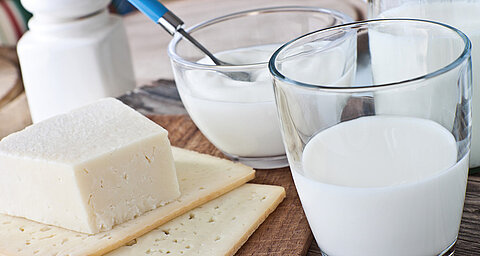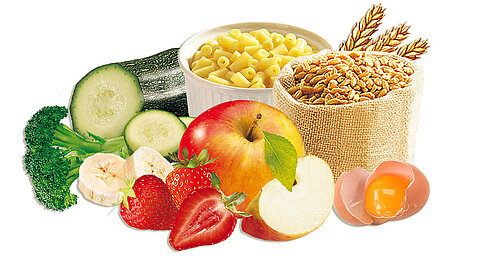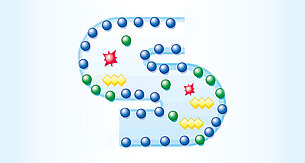Lactose intolerance

Milk and diary products are especially important for your child’s healthy growth since, among other things, they provide plenty of valuable calcium, which is needed as a building block for healthy bone growth.
Some children, however, experience problems with the lactose contained in milk, because their bodies cannot properly process lactose (lactose intolerance). Such intolerances often manifests in the form of abdominal pain, meteorism (flatulence) or diarrhoea.
In this guide, you will learn everything about lactose intolerance.
What is lactose intolerance?
Lactose intolerance is the situation where complaints occur after ingestion of lactose (‘milk sugar’). Lactose is a natural carbohydrate that is found in all dairy products.
People with lactose intolerance cannot digest lactose properly, due to a shortage of lactase, an enzyme which is necessary for digesting lactose. Thus lactose is not converted into glucose and galactose in sufficient efficiency, and large amounts reach the large intestine undigested. There, lactose is metabolised by intestinal flora, forming gas (flatulence), or may cause diarrhoea and abdominal pain after consumption of dairy products.
People with lactose intolerance are not ill, but they need to pay special attention to their diet. Thus, to acoid discomfort, the consumption of lactose must often be minimised – but at the same time, milk and milk products should not be completely avoided as they provide important nutrients. There are special lactose-free or low-lactose products available now to suit the needs of people with lactose intolerance. About 90% of Singaporeans are lactose intolerant to varying degrees.
What does the body need lactose for?
Lactose is the main carbohydrate in the milk of mammals.
Breast milk also has high lactose content (c. 7g/100ml), making it one of the most important energy sources for infants. During digestion, lactose reaches the small intestine, where it is converted into glucose and galactose. These components then enter the bloodstream through the intestinal wall and are used in the cells to produce energy. In addition, lactose supports the development of healthy intestinal flora in breast-fed infants.
Babies of breast-feeding age can generally metabolise lactose very well. Only in very rare case, lactose intolerance in innate. When a person grows older, however, the ability to digest lactose may be lost, and a “primary lactase deficiency” arises. This is the most common form of lactose intolerance and can lead to symptoms as early as childhood. In case of complaints, you should definitely consult a doctor.
Does my child suffer from lactose intolerance?

Possible symptoms and testing methods
Lactose intolerance manifests in the form of complaints in the gastrointestinal tract, which occur after the consumption of milk and dairy products. Possible symptoms include flatulence, abdominal pain, diarrhoea and nausea.
The symptoms depend heavily on the individual degree of lactose intolerance and are very unspecific. To rule out other causes for the symptoms, you should talk to your paediatrician about your suspicions.
The paediatrician can verify the suspicions of lactose intolerance by means of established test procedures.
One such test is the breath test after lactose ingestion (hydrogen breath test). This test is very reliable and is suitable for toddlers older than one year. The test requires your child to drink a lactose solution on an empty stomach. In the following house, the hydrogen content of the exhaled air is measured.
Intolerance vs. Allergy
Food allergy is very different from food intolerance Food allergy always involves the immune system. Here, the immune system responds with a defence reaction to certain substances (proteins) which are harmless for a healthy person. Often, even minimal amounts (“traces”) are sufficient to trigger a reaction. Typical allergy symptoms include sneezing, skin rashes and itching, red eyes, and shortness of breath.
In food intolerance, the immune system is not involved. Here, one cause could be the under performance or lack of activity of the digestive enzymes in the gut. This can lead to various symptoms in the gastrointestinal tract upon ingestion of the relevant food in question. Here, the amount of food ingested is very relevant. Thus, in contrast to food allergy, small amounts are often tolerated well.
Where intake of cow’s milk causes a reaction, it is important to distinguish between genuine allergy to cow’s milk protein and lactose intolerance:
In the case of cow’s milk protein allergy, cow’s milk must be completely avoided, and in consultation with your doctor, a calcium-rich alternative is to be sought.
In the case of lactose intolerance, milk and daily products can be tolerated to individually differing degrees. Some people can have up to half a cup of milk or some yogurt without any problems, while others react even to minute amounts. With lactose intolerance, the body has difficulties breaking down the lactose contained in the food. Thus, lactose-free products can be recommended.
In case of suspected cow milk protein allergy or lactose intolerance, it is important to consult a physician as soon as possible. The physician will make a reliable diagnosis and help you.
Must milk be completely avoided in cases of lactose intolerance?

Many people believe that their lactose intolerance forces them to completely avoid milk, and to adhere to a diet that does not contain any milk and diary products. However, this is not necessary, even with cases of acute lactose as varying quantities of different amounts of lactose is tolerated without any adverse reaction.
Milk and dairy products contain many healthy nutrients and are, above all, an important source of calcium. Avoiding them is therefore problematic, especially for toddlers, to ensure that they have sufficient intake of calcium for healthy bone formation. In infancy, bone growth is particularly strong.
If a low-lactose diet is desired or required in infancy, milk and dairy products should not be avoided altogether. Instead, feed your child appropriate lactose-free milk products.
Before using lactose-free formula foods, you should consult your paediatrician first. He/she can advise you and determine if this is suitable for your child.
Living with lactose intolerance
If you/your child have been diagnosed as lactose intolerant, your/your child’s diet must be changed. Lactose intolerance is not curable, but you can avoid its symptoms by taking care in your choice of diet.
At the start, foods containing lactose should be avoided to soothe the intestines. After a period of time, the intake of lactose can be resumed, by starting off with small amounts first. The amount should reflect the degree of intolerance. This serves to test how much the body can tolerate: at what time of day, in what quantity, and in connection with what other foods. Intake of lactose as part of a meal tends to be tolerated better than in between meals. Dairy products such as cheese contain very little lactose and are often very well tolerated. Yogurt is also a healthy alternative that is often well tolerated, especially in smaller quantities.
No one needs to restrict his/her diet for the rest of their lives, but sensible management is recommended. To minimise discomfort, you can choose from the lactose-free products available in the market today.

In general, the following foods are lactose-free:
- Fruit juices, mineral water, tea
- Fruits, legumes, and pure vegetables
- Pasta, rice
- Cereals, cereal flakes
- Eggs
- Honey and Jam
- Herbs, Spices
- Nuts
Foods that contain lactose:
It is always helpful to take a look at the label!
| Feta cheese, 45% fat in dry weight | 0.5g lactose/100g |
| Butter | 0.6g lactose/100g |
| Cut cheese, soft cheese, hard cheese | < 1g lactose/100g |
| Créme fraiche | 2.0-3.6g lactose/100g |
| Cream cheese, 10-70% fat in dry weight | 2.0-3.8g lactose/100g |
| Curd cheese | 2.5-3.2g lactose/100g |
| Cottage cheese | 2.5-3.4g lactose/100g |
| Sour cream | 3.0g lactose/100g |
| Yoghurt | 3.2-5.6g lactose/100g |
| Cream, 30% fat in dry weight | 3.3g lactose/100g |
| Processed cheese | 3.4-7.5g lactose/100g |
| Desserts (cream, pudding, rice pudding, etc.) | 3.5-6.0g lactose/100g |
| Buttermilk | 4.0g lactose/100g |
| Soured milk, Kefir | 4.0g lactose/100g |
| Goat milk | 4.2g lactose/100g |
| Milkshakes | 4.4-5.4g lactose/100g |
| Whey | 4.7g lactose/100g |
| Cow's milk | 4.8g lactose/100g |
| Ice cream | 5-7g lactose/100g |
| Chocolate | 9.5g lactose/100g |
| Milk powder | 38.0-51.5g lactose/100g |
Source: Souci Fachmann Kraut, 2008
Foods that may contain lactose
- please check the label and nutritional information carefully
- Margarine
- Salad dressing, mayonnaise
- Sausages
- Spreads
- Thickening agents, binding agents
- Ready-made meals, canned fish
- Pastries




